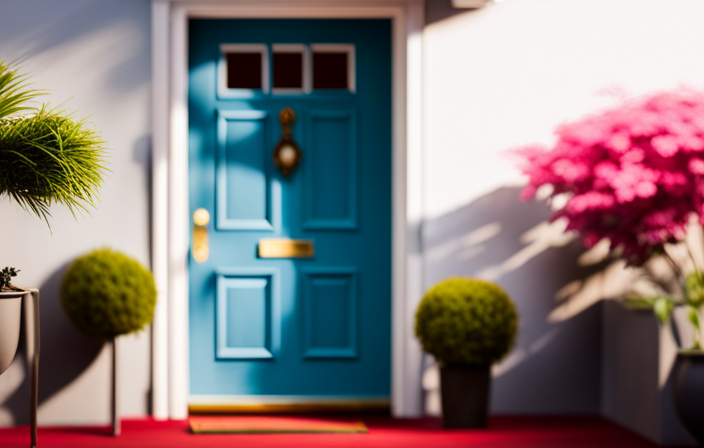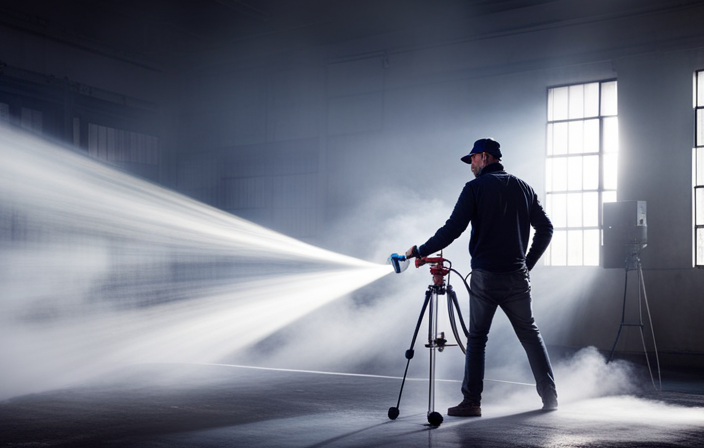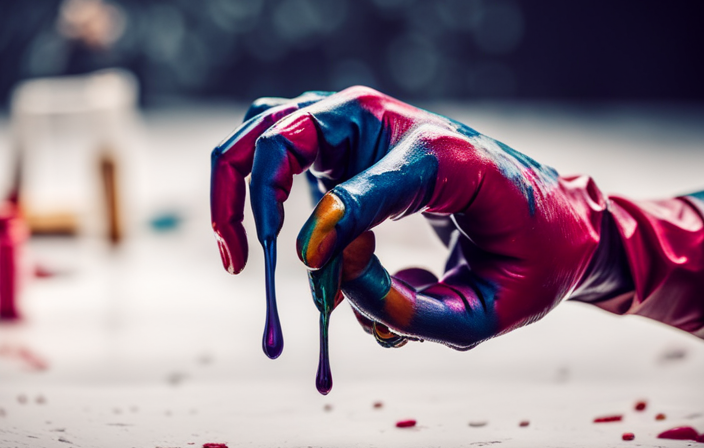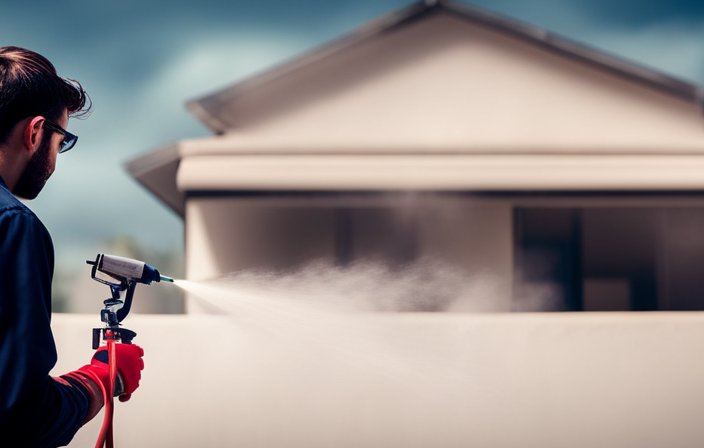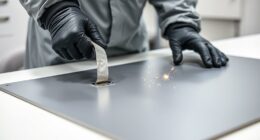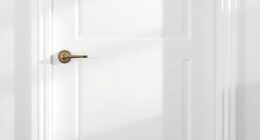Hello! Have you ever wanted to update your living space with some fresh paint but hesitated to take on the project with a traditional brush or roller? Fear not! I have the ideal solution for you: an airless paint sprayer.
This nifty tool allows you to achieve a smooth and professional finish in no time.
In this article, I’ll be your guide to mastering the art of using an airless paint sprayer. From understanding the basics to troubleshooting common issues, I’ll cover it all.
We’ll start by preparing your workspace and materials, making sure you have the right safety precautions and protective gear in place.
Then, I’ll show you how to set up and adjust your airless paint sprayer for optimal results.
But that’s not all! I’ll also share some pro tips and techniques to help you achieve that flawless finish you’ve been dreaming of.
So, grab your paint sprayer and let’s get started on transforming your space with ease and precision.
Key Takeaways
- Achieving even coverage with an airless paint sprayer is important to prevent patchy areas and ensure a smooth finish.
- Troubleshooting common issues with an airless paint sprayer involves checking pressure settings, preventing clogging in the spray tip, and regular maintenance.
- Finalizing the paint job may involve using a brush for smaller areas or intricate details, choosing the right primer for different surfaces, and considering factors for a flawless paint job.
- Key tips and techniques for using an airless paint sprayer include overlapping strokes for even coverage, maintaining a steady pace and distance, cleaning and maintaining the sprayer, choosing the right primer, and using brushing for a controlled and precise finish.
Understanding the Basics of an Airless Paint Sprayer
Now that you’ve got your hands on an airless paint sprayer, let’s dive into the basics and get you spraying like a pro in no time!
Airless paint sprayers are a powerful tool that can make your painting projects a breeze. The basics of airless paint sprayers involve understanding how they work and the advantages they offer.
Unlike traditional paint sprayers that use compressed air, airless sprayers use a high-pressure pump to force paint through a small opening, creating a fine mist of paint. This allows for faster and more even coverage, saving you time and effort.
The advantages of using airless paint sprayers include the ability to handle thicker paints, reduced overspray, and the ability to reach difficult areas.
Now that you know the basics, let’s move on to preparing your workspace and materials for a flawless paint job.
Preparing Your Workspace and Materials
Before starting any painting project, it’s important to clear the area and protect surfaces to avoid any accidental damage. This can involve removing furniture, covering floors, and nearby objects with drop cloths, and taping off areas that shouldn’t be painted.
Additionally, choosing the right paint and equipment is crucial for achieving the desired results. Considering factors such as the type of surface to be painted, the finish desired, and the specific paint sprayer being used will help ensure a successful and efficient painting experience.
Clearing the Area and Protecting Surfaces
To properly protect surfaces while using an airless paint sprayer, make sure you cover them with a drop cloth or clear plastic sheeting. This can reduce the risk of accidental paint splatters by 75%. By taking these precautions, you can save yourself a lot of time and effort in cleaning up afterward.
Here are some tips to help you clear the area and protect surfaces effectively:
- Remove any furniture and fixtures from the workspace to create more space and prevent them from getting damaged.
- Use clear plastic sheeting to cover larger areas like floors and furniture. This’ll provide a transparent barrier and allow you to see the surface underneath.
- Secure the drop cloth or plastic sheeting using tape or weights to prevent it from moving or shifting during the painting process.
- Cover any delicate or fragile items with additional protection, such as bubble wrap or cardboard, to safeguard them from paint splatter or accidental bumps.
- Ensure that all edges and corners are properly covered to avoid any paint seeping underneath.
Taking these precautions will ensure a clean and professional-looking paint job.
Now, let’s move on to the next section about choosing the right paint and equipment.
Choosing the Right Paint and Equipment
Selecting the proper paint and equipment is crucial for achieving a flawless and professional finish. When it comes to paint color options, it’s important to consider the type of surface you’re painting and the desired outcome.
Whether you’re looking for a bold statement or a subtle touch, there are countless colors to choose from. Additionally, the spray gun you use can greatly affect the final result. Different spray gun options offer various spray patterns and pressure settings, allowing for more control and precision. It’s essential to choose a spray gun that suits your specific project needs.
Now that we’ve covered the importance of selecting the right paint and equipment, let’s move on to discussing safety precautions and protective gear to ensure a safe and successful painting experience.
Safety Precautions and Protective Gear
Remember, you’ll want to make sure you’re wearing the proper safety gear, like goggles and a respirator, when using an airless paint sprayer to protect yourself from any potential hazards.
When it comes to respirator types, there are a few options to consider. The most common type is the disposable respirator, which provides basic protection against paint fumes and particles. For more advanced protection, you may want to invest in a half-face respirator with replaceable cartridges that can filter out a wider range of contaminants.
Additionally, safety goggles are essential for protecting your eyes from any overspray or splatters. Make sure they fit snugly and provide good coverage.
Now that you have your safety gear sorted, let’s move on to setting up and adjusting your airless paint sprayer, ensuring a smooth and efficient painting process.
Setting Up and Adjusting Your Airless Paint Sprayer
Now that you’ve got all your safety gear on, let’s dive into the process of setting up and adjusting your airless paint sprayer for a seamless painting experience.
Before getting started, it’s important to adjust the pressure on your sprayer according to the type of paint and surface you’ll be working with. Start with a low pressure setting and gradually increase it until you achieve the desired spray pattern and coverage.
If you encounter any clogs during the process, don’t panic. Troubleshooting clogs is relatively easy with an airless paint sprayer. Simply remove the clogged nozzle or tip, clean it thoroughly, and reattach it.
Remember to always follow the manufacturer’s instructions for your specific sprayer model.
Now, let’s move on to the next section where we’ll discuss practicing proper technique to ensure a professional finish.
Practicing Proper Technique
Mastering the art of painting is like orchestrating a symphony of colors and strokes, and practicing proper technique is the key to creating a masterpiece. When using an airless paint sprayer, it is crucial to have a proper grip on the sprayer to maintain control and stability. Your grip should be firm but not too tight, allowing for smooth and steady movements. Additionally, achieving an even finish requires maintaining a consistent distance between the sprayer and the surface being painted. To help you visualize this, here is a table depicting the proper technique for achieving an even finish:
| Technique | Description |
|---|---|
| Overlap | Each stroke should overlap the previous one by 50%. |
| Speed | Move the sprayer at a moderate, steady pace. |
| Angling | Hold the sprayer at a slight angle, about 12-18 inches from the surface. |
By mastering these techniques, you can ensure a professional-looking paint job. Now let’s move on to the next section about starting and stopping the sprayer smoothly.
Starting and Stopping the Sprayer
To ensure a smooth and enjoyable painting experience, let’s talk about how to effortlessly start and stop the sprayer.
Starting the airless paint sprayer is a simple process. First, make sure the sprayer is plugged in and the power switch is turned on. Then, prime the sprayer by filling the hose with paint and releasing any air bubbles. Once the sprayer is primed, hold the spray gun firmly and squeeze the trigger to start spraying.
To stop the sprayer, release the trigger and allow the pressure to fully release before turning off the power switch. Troubleshooting common problems with starting and stopping the sprayer include checking for clogs in the nozzle, ensuring proper paint flow, and adjusting the pressure settings.
Now that we know how to start and stop the sprayer, let’s move on to painting techniques and tips.
Painting Techniques and Tips
When it comes to achieving even coverage with an airless paint sprayer, one important technique is overlapping strokes. By slightly overlapping each stroke as you move the sprayer across the surface, you can ensure that every inch is covered and avoid any patchy areas.
Another key tip is maintaining a steady pace and distance from the surface. This helps to prevent drips or uneven paint application, resulting in a professional-looking finish.
Overlapping Strokes for Even Coverage
Ensure a flawless paint job by smoothly overlapping your strokes with an airless paint sprayer – it’s the key to achieving even coverage effortlessly!
When using an airless paint sprayer, overlapping strokes is crucial for a smooth finish. By overlapping each stroke by about 50%, you ensure that every inch of the surface is covered evenly. This technique helps to eliminate any streaks or lines that can occur when painting with a sprayer.
Remember to maintain a steady pace and distance as you move the sprayer across the surface, ensuring consistent coverage. By following these steps, you can achieve a professional-looking paint job that will impress anyone who sees it.
Now, let’s move on to the next section about maintaining a steady pace and distance for optimal results.
Maintaining a Steady Pace and Distance
Maintaining a consistent rhythm and distance while gliding the tool across the surface will result in a flawlessly smooth finish. To achieve this, it is crucial to maintain consistency in your pace and distance throughout the painting process. By doing so, you can avoid overspray and ensure an even coverage. To help you visualize this, here is a table that outlines the ideal pace and distance for optimal results:
| Pace (inches per second) | Distance (inches) |
|---|---|
| 6 | 10 |
| 8 | 12 |
| 10 | 14 |
| 12 | 16 |
| 14 | 18 |
Following these guidelines will help you maintain a smooth and consistent application. Now, let’s move on to troubleshooting common issues that may arise during the painting process without interrupting the flow.
Troubleshooting Common Issues
Having trouble with your airless paint sprayer? Let’s tackle some common issues and get you back to painting in no time!
When it comes to troubleshooting common problems with your airless paint sprayer, there are a few tips that can help. First, check the pressure settings on your sprayer to ensure they’re properly adjusted. If the pressure’s too low, the paint may not atomize properly, resulting in a poor finish. Conversely, if the pressure’s too high, you may end up with excessive overspray.
Another common issue is clogging in the spray tip. This can be caused by dried paint or debris in the system. To fix this, simply remove the tip and clean it thoroughly.
Lastly, make sure to check the filters and screens for any blockages. By following these troubleshooting tips, you can overcome common issues and continue painting smoothly.
Now, let’s move on to the next section about cleaning and maintenance of your airless paint sprayer.
Cleaning and Maintenance of Your Airless Paint Sprayer
Keep your airless paint sprayer in top condition by regularly cleaning and maintaining it, so you can ensure optimal performance and longevity. Proper cleaning is essential for preventing clogs and ensuring a smooth paint application.
After each use, make sure to thoroughly clean the sprayer by flushing it with water or a cleaning solution. Pay attention to the nozzle, filters, and hoses, as these areas are prone to buildup and blockages.
If you encounter any issues, such as uneven spray patterns or excessive overspray, refer to the troubleshooting guide provided by the manufacturer. By following these cleaning tips and troubleshooting problems promptly, you can keep your airless paint sprayer functioning at its best.
Now, let’s move on to finalizing your paint job and achieving professional-looking results.
Finalizing Your Paint Job
To achieve a truly professional finish, take the time to perfect your paint job by giving attention to the final details. This includes making a decision between brushing and spraying.
While airless paint sprayers offer a quick and efficient way to apply paint, brushing can provide a more controlled and precise finish, especially when working on smaller areas or intricate details.
Additionally, choosing the right primer is crucial for a long-lasting and durable paint job. Primers act as a preparatory coat, helping to seal surfaces, provide adhesion, and enhance the overall finish of your paint.
Depending on the type of surface you’re working with, there are different primers available, such as oil-based or water-based primers.
By carefully considering these factors, you can ensure a flawless and professional-looking paint job.
Frequently Asked Questions
Can I use any type of paint with an airless paint sprayer?
You can use various types of paint with an airless paint sprayer. However, it’s essential to prepare the paint properly before using it. Let me share an interesting statistic about airless paint sprayers…
How do I prevent overspray when using an airless paint sprayer?
To prevent overspray when using an airless paint sprayer, I recommend using proper technique. Start by adjusting the pressure and fan width settings, maintaining a consistent distance from the surface, and using masking or shielding to protect surrounding areas.
What is the recommended pressure setting for different types of paint?
When using an airless paint sprayer, it’s important to know the recommended pressure settings for different types of paint. For example, latex paint typically requires a pressure setting of 2,000-2,500 PSI, while oil-based paint may need 1,200-1,500 PSI.
Can I use an airless paint sprayer for intricate or detailed painting projects?
Yes, an airless paint sprayer can be used for small projects, but it may not be the best choice for intricate or detailed painting. For those types of projects, alternative painting methods are recommended.
How do I clean the filters and nozzles of an airless paint sprayer?
To clean the filters and nozzles of an airless paint sprayer, start by disconnecting the sprayer from the power source. Remove the filters and nozzles, and clean them using warm soapy water. Rinse thoroughly and reassemble. Regular maintenance is crucial for optimal performance and longevity. For troubleshooting common issues, refer to the manufacturer’s guide or seek professional assistance. Remember, proper maintenance ensures efficient and effective painting results.
Conclusion
In conclusion, using an airless paint sprayer is a game-changer for any DIY enthusiast or professional painter. By understanding the basics and taking necessary safety precautions, you can achieve flawless and efficient paint jobs.
With the right setup and technique, you’ll be able to tackle any project with ease. Remember to troubleshoot any issues that may arise and maintain your sprayer for long-lasting performance.
So, whether you’re painting walls, furniture, or even exteriors, an airless paint sprayer is the tool you need for a professional finish every time.
Happy painting!



